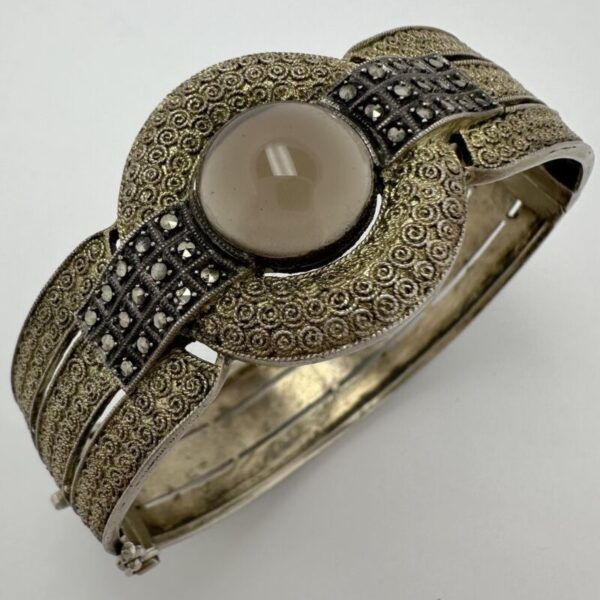#Marcasite #Hematite #Identify #Gray #Jewelry #Materials #WorthPoint
As I’m perusing online jewelry listings, whether shopping or doing research, I sometimes come across things that just aren’t quite right. For instance, I recently noticed cut steel described as marcasite, and marcasite presented as hematite. Maybe the person writing the listing had a memory lapse and used the wrong word. I’ve done that before, and later, I had a “duh” moment when it was noticed and corrected. When I see the same mistakes happening several times, though, it’s usually because people are still trying to make sense of all these terms for components and need a little more education.
Whether you’re just learning about jewelry buying and selling and need a bit more information on this gray area (pun intended!) of collecting, or you don’t mind a good refresher, here are several different types of gray materials you’ll likely run across if you keep thrifting and hitting the fleas for any amount of time.
Marcasite
If you’ve heard of “fool’s gold” in the form of pyrite, you’re familiar with the mineral used to create marcasite stones. These small, faceted gems were first used in the 18th century to imitate diamonds. That might be hard to believe, given their gray appearance, but they do sparkle under candlelight, and diamonds often had a duller, rougher appearance during the Georgian era. The use of these stones was revived in the mid-1850s and then had another period of popularity during the 1920s, with most pieces crafted using sterling silver.
The tricky part about marcasite jewelry is that it saw another resurgence in popularity much later, and it’s been used since then in many sterling silver pieces. Some of these are unique designs, but many mimic the look of Victorian or art deco styles. When dating these pieces, you often have to look for clues like the way they are set or the presence of older findings. For instance, antique marcasites are usually bead-set, while newer ones are glued into the settings. Victorian brooches will usually have C-shaped clasps instead of safety catches. Most older marcasites are round but were made in other shapes in the mid-to-late 20th century.
Some marcasite jewelry is marked as well. Theodor Fahrner’s German workshop combined marcasite with pearls, chrysoprase, and lesser value gemstones like amethyst and spinel in Jugendstil and art deco designs in the first part of the 20th century. Judith Jack—a company founded by Judith and Jack Rosenberg—began producing marcasite jewelry inspired by antique and vintage pieces many decades later. These also include lesser-value gemstones like amethyst or glass-simulating materials like onyx and chrysoprase.
Many other companies also made jewelry combining stones like blue topaz, citrine, and peridot with marcasites in the ’70s, ’80s, and ’90s. Most of them are only stamped 925, indicating the metal content, but they were produced in Thailand and are marked as such.
Cut Steel
Another gray material embellishing antique jewelry is cut steel. Many of these little components are round, but others are crescent or elongated marquise in shape. Due to their gray coloring and faceting, they are sometimes mistaken for marcasites. Looking at the round, dome-shaped components closely, though, it’s easy to see that they have many facets rather than being pointed on top like marcasites. The main difference, however, is the way they’re mounted; rather than being bead-set or glued, they’re screwed or riveted to a base.
The first cut steel items were mainly buckles and buttons. By the mid-1700s, jewelers increasingly made pieces using these shiny metal “stones.” Most of the brooches and buckles made of cut steel found today date to the 19th century. Like marcasite, cut steel was considered an acceptable material to wear during mourning, at least in the later periods. Buckles for belts and shoes are still found fairly readily. They are generally more reasonably priced than pins, bracelets, and pendants made using cut steel.
Hematite and Hematite Rhinestones
Hematite is another gray mineral used in antique jewelry that can sometimes be confused with marcasite. It gets its name from the Greek term for blood, haema, since it is red when sliced or pulverized to use as a pigment. Many intaglios were carved using hematite during the Victorian era, but hematite can also be faceted and set like a gemstone into a pendant or pair of earrings. The practice of using hematite intaglios was revived in the art deco era and again in the 1960s, so you often have to examine the style of the setting to determine the age.
Natural hematite is still used in modern jewelry, including strands of beads in necklaces and bracelets. The ancient Egyptians believed this mineral would ward off blood-related illnesses and bleeding, while today, it’s sometimes worn as a grounding element as well as for protection. In the Victorian era, it could be worn in the later stages of mourning, like marcasite and cut steel.
You may also run across rhinestone jewelry with embellishments resembling hematite. These black glass stones named Jet Hematite have a shiny coating that can wear away if the jewelry is not stored properly. A lighter-colored variation of these stones is called Crystal Comet Argent Light by Swarovski. These clear glass stones have a silvery gray coating. Using abrasive polishing cloths on these types of coated rhinestones can also cause the finish to wear away. However, when they’re still in excellent condition, they do a good job of imitating other gray materials.
Pamela Siegel is a freelance writer and author who has been educating collectors for more than two decades. In addition to three books on topics relating to antiques and collectibles, she frequently shares her expertise through online writing and articles for print-based publications. Pamela is also the co-founder of Costume Jewelry Collectors Int’l (CJCI) and the proprietor of Chic Antiques by Pamela.
WorthPoint—Discover. Value. Preserve.




